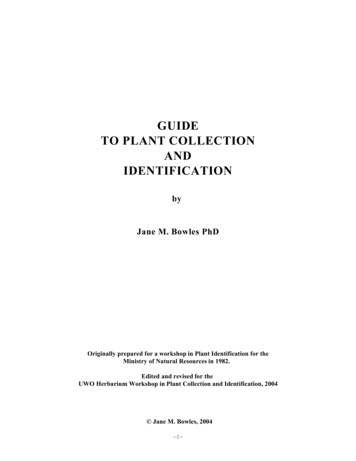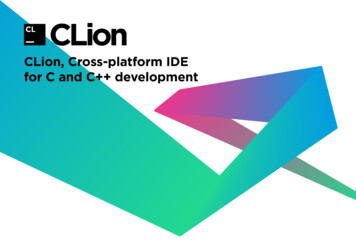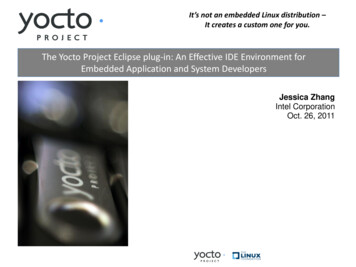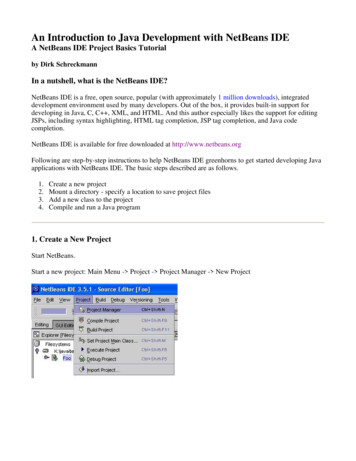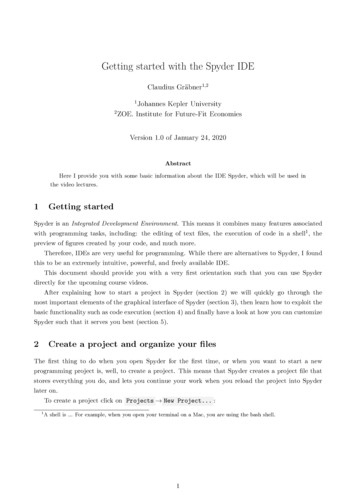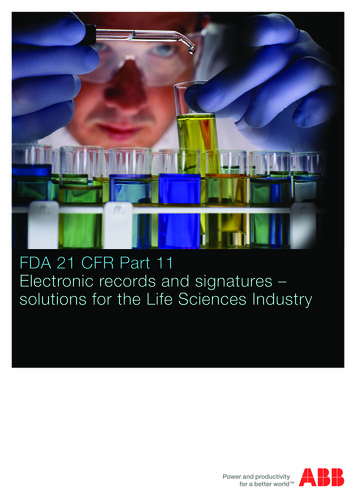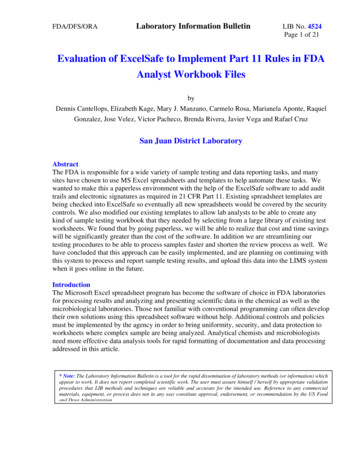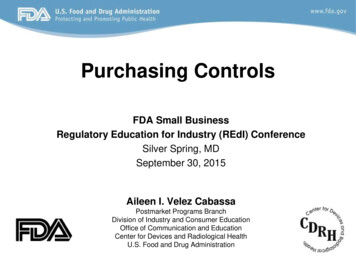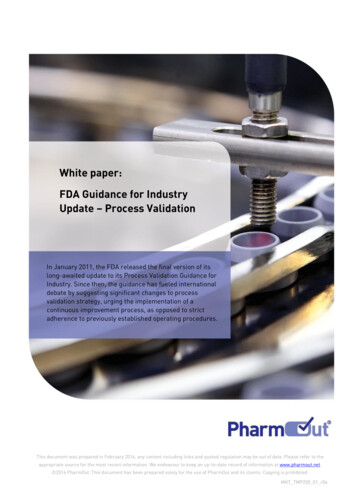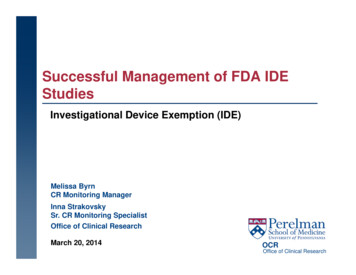
Transcription
Successful Management of FDA IDEStudiesInvestigational Device Exemption (IDE)Melissa ByrnCR Monitoring ManagerInna StrakovskySr. CR Monitoring SpecialistOffice of Clinical ResearchMarch 20, 2014OCROffice of Clinical Research
Learning Objectives Determine when an IDE is required Know how to file an IDE Application Identify strategies for IDE management Establish a plan for device management and accountability Interpret common IDE audit findingsOCROffice of Clinical Research 2
What is a medical device? Instrument/machine/apparatus/related article which is: Intended for use in the diagnosis, cure, mitigation, treatment orprevention of disease Intended to affect the structure/function of the body– and does not achieve its primary purpose through chemical action(i.e. not a drug)OCROffice of Clinical Research 3
What is an investigational device? A device that is the object of an investigation All clinical investigations of devices must have an approvedIDE or be exempt from IDE regulationsOCROffice of Clinical Research 4
What is an IDE? Investigational Device Exemption (IDE) Application Request for authorization from the FDA to test an investigational device forsafety and effectiveness in humans in a clinical study IDE Regulatory Sponsor is: Person or company who has filed the IDE with the FDA Regulations: 21 CFR 812OCROffice of Clinical Research 5
DefinitionSponsorA person/company who initiates, but does not actuallyconduct, the investigation. The investigational device isadministered, dispensed, or used under the immediatedirection of another individual. (21 CFR 812.3(n))OCROffice of Clinical Research 6
IDE Sponsor Responsibilities Obtain FDA approval of IDE application prior to study start Ensure IRB approval is obtained at all sites Select qualified investigators Obtain signed agreements from all investigators Obtain financial disclosure information from all investigators Train Penn staff/other sites on protocol requirements Ensure investigation is conducted according to the generalinvestigational plan and protocol at all sitesOCROffice of Clinical Research 7
IDE Sponsor Responsibilities Ensure all significant new information is promptlycommunicated to the FDA and the IRB Maintain accurate, complete, and current records Select qualified monitors and ensure proper monitoring of theinvestigation at all sites (if applicable) Evaluate any unanticipated adverse device effects Control the investigational device and ensure it is properlylabeled Provide reports to the FDA and IRBOCROffice of Clinical Research 8
DefinitionInvestigatorThe individual who conducts a clinical investigation. Anindividual under whose immediate direction the testarticle is administered or dispensed to, or usedinvolving, a subject. If a team is involved, the leader isthe investigator. (21 CFR 812(i))OCROffice of Clinical Research 9
IDE Investigator Responsibilities Protect rights, safety, welfare of subjects Ensure investigation is conducted according to signedagreement, investigational plan, applicable regulations Ensure informed consent is obtained Control devices under investigation Communicate appropriately with the Sponsor, IRB, andresearch team Follow the Sponsor’s instructions for investigational devicedisposal or return Disclose accurate financial information to the Sponsor Maintain accurate, complete, and current recordsOCROffice of Clinical Research 10
DefinitionSponsor-InvestigatorAn individual who both initiates and actually conductsan investigation. The obligations of a sponsorinvestigator include those of an investigator and thoseof a sponsor. (21 CFR 812.3(o))OCROffice of Clinical Research 11
Significant Risk Device An investigational device that: presents a potential for seriousrisk to the health, safety or welfare of a subject AND Is intended as an implant OR For use supporting or sustaining human life OR Substantial importance in diagnosing, curing, mitigating, or treatingdisease or otherwise preventing impairment of human health OR Requires an IDE Determination of SR must be confirmed by IRBOCROffice of Clinical Research 12
Non-Significant Risk Device Does not meet the criteria of a SR device Does not require an IDE, but must meet certain regulatoryrequirements Examples: labeling requirements, IRB approval, informed consent,monitoring, etc. Study must be approved by an IRB – must agree on NSRdetermination21 CFR 812.2(b) Abbreviated requirementsOCROffice of Clinical Research 13
Devices Exempt from IDE Regulations Distributed, marketed, and used according to their approvedindication Substantially equivalent devices that go through a FDA reviewprocess Some in-vitro diagnostic devices Device undergoing consumer preference or modificationtesting Custom device not intended for commercial distributionOCROffice of Clinical Research 14
FDA GuidanceSignificant Risk and Non-Significant Risk Medical DeviceStudiesU.S. Department of Health and Human ServicesFood and Drug AdministrationCenter for Devices and Radiological Health (CDRH)January tion/guidances/ucm126418.pdfOCROffice of Clinical Research 15
Request for FDA Feedback FDA has mechanisms for providing feedback before asubmission (“Q-Sub”) Formal written request from a sponsor for feedback from FDAvia a formal written response, teleconference, or meeting Purpose: provide opportunity for sponsor to obtain FDAfeedback prior to an IDE submission or marketing application Timeframe: 75-90 daysOCROffice of Clinical Research 16
Pre-Submission Meeting with FDA Pre-Submission meeting can be helpful if: New device involves novel technology “First of a kind” indication New indication for existing device New device does not clearly fall within an established regulatorypathway Specific protocol design questions Clarification of how much existing data may be leveraged in futurePMA submissionOCROffice of Clinical Research 17
Types of Pre-Submissions Pre-IDE Request for feedback from FDA Determination Meeting– Identify types of scientific evidence necessary to demonstratedevice effectiveness– For applicants who plan to submit a PMA down the line or wouldbenefit from additional input from FDA on trial design or preclinical testing Study Risk Determination– Assistance with SR, NSR, exemption determination Agreement Meeting– Any applicant investigating a Class III device or any implant– Reach agreement on key parameters of investigational planOCROffice of Clinical Research 18
Request for Feedback Using FDA Form 3514OCROffice of Clinical Research 19
Preparing an IDE ApplicationOCROffice of Clinical Research
You Need an IDE Now What?Submit protocol to IRBDevelop IDE Application1Once protocol is approved by IRBsubmit IDE to FDA2FDA provides IDE number with dateFDA received IDEAfter 30 days IDE is in effect IF FDAhas not requested modifications ordisapproved IDE1This can happenat any time duringthe process2You can submitthe protocol to IRBand the IDE to FDAat the same time.However, if theprotocol is revisedbased on IRBstipulations, you willneed to resubmit toFDA.OCROffice of Clinical Research 21
IDE Application Content Cover Letter Report of prior investigations (animal, lab, clinical testing ofdevice) Study protocol Method, facilities and controls for the manufacturing andprocessing, packing and storage of the device Investigator agreements Names and addresses of all investigators and sites Names and addresses of all IRBs that will be reviewinginvestigation Amount charged for the device, if any, and rationale for why itisn’t commercializing device at that price Product labeling Informed Consent Forms Additional informationOCROffice of Clinical Research 22
IDE Content: Cover Letter Statement that information provided is an original IDEsubmission Device name and intended use Sponsor name and contact information Manufacturer information Summary of Pre-Sub meetings or discussions with the FDA Any requests for waivers Referenced files (PMA, 510(k), IDE, or device master files) Statement that eCopy contains an exact copy of the printedapplication (or explanation of why it does not) Sponsor’s signatureOCROffice of Clinical Research 23
IDE Content: Report of Prior Investigations Comprehensive report of prior lab, animal and clinical testingof the device Positive or negative Published or unpublished Should justify the proposed investigation Bibliography of publications Statement that lab data was collected in compliance with GoodLaboratory Practice (GLP) or brief statement of noncompliance(if applicable)OCROffice of Clinical Research 24
IDE Content: Investigational Plan Purpose Protocol Risk Analysis Device description Address each component, ingredient, property, principle of operation Anticipated changes in device over course of investigationOCROffice of Clinical Research 25
IDE Content: Investigational Plan Monitoring Procedures Description of procedures Name and address of monitor Single-site Sponsor-Investigators are not required to submit aMonitoring Plan– FDA assumes the investigator will monitor the study (unlessspecified otherwise) If sites are added to a single-site Sponsor-Investigator IDE– Monitoring plan will need to be submitted to the FDAOCROffice of Clinical Research 26
IDE Content: Device Manufacturing Information Description of methods, facilities and controls used for: Manufacturing Processing Packing Storage Installation (as applicable) Include Sufficient information to allow assessment of good manufacturingpractices and quality of controls Copies of all device labeling Amount to be charged for the device, if any, with justificationOCROffice of Clinical Research 27
IDE Content: Investigator Agreement Example of agreement investigators will sign No FDA-specified format Includes statements related to the responsibilities of investigators inconducting a protocol under an IDE Also include list of the names and addresses of all investigators Certification statement that all investigators who participate havesigned the agreement and that no investigators will be added untilan agreement has been signedOCROffice of Clinical Research 28
IDE Content: IRBs and ICFs Include name and address of all IRBs that have or will beasked to review the study Name of IRB Chairperson, if disclosed by IRB Certification of IRB action/decision (when available) Sample of the consent form(s) that will be provided to sitesOCROffice of Clinical Research 29
FDA Forms There are no FDA Forms to accompany the IDE application Certain information still needs to be collected and retained For example, may need to register on ClinicalTrials.gov– But FDA does not require the submission of a Form 3674 with anIDE applicationOCROffice of Clinical Research 30
Preparing to Submit the IDE 1 paper copy 2 electronic copies eCopy of the paper submission on a CD, DVD, or flash drive IDE Sponsor must be located in the U.S. IDE Sponsor must be the person submitting the IDEapplication Unless authorization in writing for another to submit on their behalfFDA Guidance for Industry: eCopy Program for Medical Device Submissions. October 10, 794.pdfOCROffice of Clinical Research 31
Common IDE Submission Problems Inadequate report of prior investigations Limited rationale and description of lab and animal studies Failure to identify relevant information in literature search summary Inadequate protocol / design plan Unclear or underdeveloped study objectives Unacceptable risks to subjects likely based on plan Inadequate monitoring plan Design and manufacturing deficiencies Inadequate characterization of the device and its operation Validation testing not sufficientOCROffice of Clinical Research 32
FDA Action on IDE Applications FDA will notify Sponsor in writing of the date it receives theIDE application IDE becomes effective 30 days after the submission has beenreceived by FDA Unless FDA has informed the sponsor prior to 30 days that the IDE isapproved, approved with conditions, or disapprovedOCROffice of Clinical Research 33
FDA Approval of an IDE FDA decision letter will include: IDE number Strict subject enrollment limits Device Categorization (A or B) Possible conditions or recommendations that can be addressed orconsidered– But enrollment may beginOCROffice of Clinical Research 34
Device Categorization by FDA FDA will categorize the device as either Category A or B For purposes of reimbursement under the Medicare program FDA will copy the Health Care Financing Administration on allapproval and conditional approval letters This will notify Medicare of the device category assigned by the FDAOCROffice of Clinical Research 35
FDA Approval with Conditions Issues do not preclude FDA from granting approval FDA letter will address conditions Sponsor must submit additional information within 45 days fromthe date of the FDA’s Decision Letter Submit via an IDE Supplement Sponsor may begin enrollment once IRB approval had beenreceived unless clinical holdOCROffice of Clinical Research 36
Disapproval of IDE Sponsor may not initiate clinical investigation until an IDEamendment is submitted Must address deficiencies identified in FDA letter Reasons for Disapproval Failure to comply with regulations False or omitted information in application Risk-to-benefit ratio not appropriate Scientifically unsound Device concernsOCROffice of Clinical Research 37
Other Types of IDE Submissions Emergency Use Compassionate Use Treatment Use Continued AccessOCROffice of Clinical Research 38
Management of an IDEOCROffice of Clinical Research
Sponsor Responsibilities: Maintaining an IDE Financial Di
Request for Feedback Using FDA Form 3514. OCR Office of Clinical Research Preparing an IDE Application. 21 OCR Office of Clinical Research You Need an IDE Now What? Submit protocol to IRB Develop IDE Application1 Once protocol is approved by IRB submit IDE to FDA2 FDA provides IDE number with date FDA received IDE After 30 days IDE is in effect IF FDA has not requested

